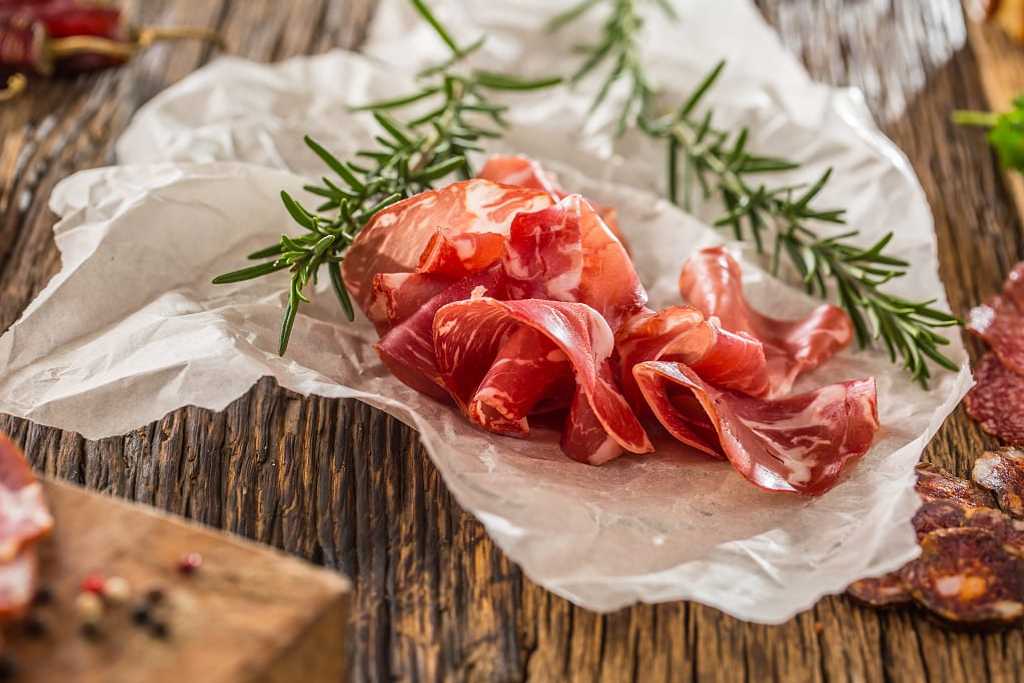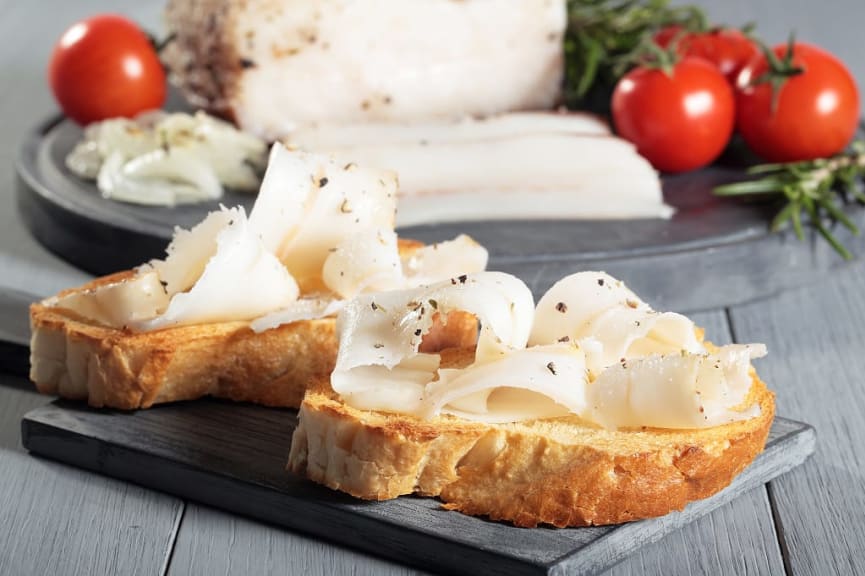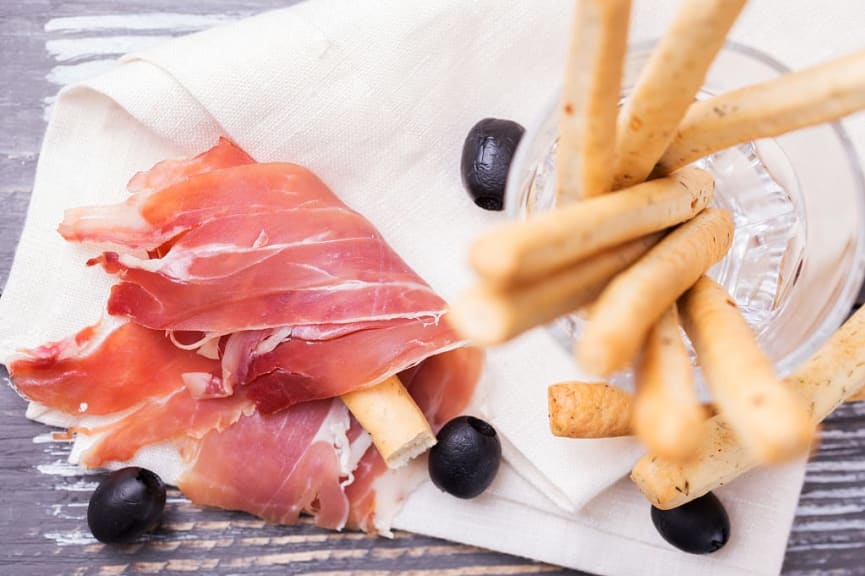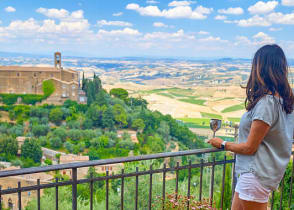14 Best Italian Cured Meats to Try on Vacation

Coppa di Parma
Cured meats are a culinary staple across the Italian peninsula and you can enjoy 14 of the best during your travels in Italy.
The Italian term for cured meats is salumi and is differentiated from French charcuterie by the meats used, their flavor, and the Italian methods of preparation and preservation. When visiting a deli in any region, you will find the country’s renowned salumi on display.
The following list offers information on the 14 best types of salumi from across Italy and where you can find each during your Italy vacation.
1. Bresaola • Lombardy

Bresaola
Bresaola is a salted, slightly aged beef dried in a room heated by a wooden fire. The cured meat is lean and reminiscent of pastrami, but thinner. It is often served as an antipasto on its own and is similar to carpaccio, with thin slices covering the plate. Chefs or cooks typically add shaved Parmigiano-Reggiano for extra flavor. More upscale dishes add shaved white truffles or sliced, marinated mushrooms.
As you travel through Lombardy’s Valtellina area on northern Italy tours and vacations, you will come across Bresaola branded with an Indicazione Geografica Protetta (IGP) label that signifies its authenticity to the region.
2. Cacciatore • Friuli Venezia Giulia, Piemonte, Emilia-Romagna, and More

Cacciatore
Cacciatore is a classic, cured meat typically made in northern Italy with caraway, coriander, dried red chili, black pepper, pork, venison, and wild boar. However, a variation of Cacciatore salami from southern Italy is made with fennel seeds, hot paprika, and ground chili. It is fermented and cured for three weeks, and most often eaten during lunch or dinner as an appetizer.
A Protected Designation of Origin (PDO) label safeguards the authenticity of the meat by ensuring it is made in specific regions with pigs raised in Friuli Venezia Giulia, Lombardy, Piemonte, Emilia-Romagna, Umbria, Tuscany, Marche, Lazio, Abruzzo, and Molise. Two-week trips to northern Italy provide a great opportunity to enjoy Cacciatore during your travels.
3. Capicola • Calabria

Capicola
Capicola, commonly known as capocollo in Italy, is a classic cured meat made from pork neck or shoulder, with paprika, spices, and herbs. It is also dry-cured, very thinly sliced, and commonly served as an appetizer or snack.
As you travel to Calabria on tours of southern Italy, you will discover Capicola salami made from Large White and Landrace pigs farmed in the region's ideal climate and cured in high temperatures and natural humidity. A PDO label safeguards the type and quality of the meat, as well as the locations in which it is cultivated and produced.
4. Coppa • Emilia-Romagna

Coppa
Coppa is a cured Italian meat that’s aged for at least six months, but less than a year. It’s made from boneless pork shoulder and hand-rubbed with spices such as cinnamon, cloves, bay seeds, and nutmeg. It can also contain chili pepper, depending on the province in which it is produced.
The popular salami possesses the PDO label, ensuring its authentic production in the Arda Valley of Emilia-Romagna, and you can enjoy it on Emilia-Romagna itineraries. The tradition of the Coppa Piacentina DOP has been passed down through the generations and it is now produced in various provinces within the Emilia-Romagna region, including Pianello Val Tidone, Bettola, and Gragnano Trebbiense.
5. Cotechino • Molise, Trentino, Veneto, and More

Cotechino
The traditional Italian salami Cotechino is made from a combination of pork and spices inside natural sheep casings, but unlike most cured meats in Italy, Cotechino is primarily cooked before eating and served fried with lentils.
Cotechino salami has gained Protected Geographical Indication (PGI) status, preserving the production of the cuisine under Italian and European law, and ensuring the cured meat is made in Emilia-Romagna, Lombardy, Molise, Trentino, Veneto, the hills of Irpinia, and a small province in the Campania region. You can savor Cotechino on any of our Venice vacations in the Veneto region.
6. Culatello • Emilia-Romagna and Lombardy

Culatello
Often referred to as the filet mignon of prosciutto, Culatello is an exquisite cured meat made from the rear legs of a pig and mixed with wine and pepper, before aging between 10 and 12 months for a delicate, but noticeable flavor.
Culatello di Zibello has gained PDO status, celebrating the delicacy whose tradition dates back to at least the 15th century. The authentic cut must derive from pigs born and raised in Emilia-Romagna or Lombardy, and processed in the communes of Busseto, Zibello, Soragna, and Roccabianca in the Parma province. On 10-day tours of northern Italy, you can visit cities in Emilia-Romagna and Lombardy to try the iconic cured meat.
7. Guanciale • Umbria and Lazio

Guanciale
Guanciale is a traditional Italian cured meat made from pork jowl or belly fat, and often used as a cooking ingredient to imbue dishes such as pastas, risottos, and stews with depth and richness. It is commonly flavored with black pepper, garlic, and rosemary, permeating the inner layers of the meat during the curing process.
It plays a starring role in dishes from Umbria and Lazio, such as the classic pastas of amatriciana and carbonara. At restaurants in these regions, you will find silky Guanciale used to enhance the flavors of main fish dishes and side dishes with sautéed vegetables typically served at lunch or dinner. Umbria borders the Tuscan region, making it possible to visit and try authentic Guanciale during two-week Tuscany tours.
8. Lardo • Tuscany

Lardo
Lardo is made with black pepper, nutmeg, and other savory spices or herbs mixed with pork fat during the curing process. While not meat itself, the creamy texture and luscious flavor have developed a popular following, especially in the northern region of Val d’Aosta, in addition to neighboring areas known for long, cold winters.
Cured Lardo can be eaten on its own and is often sliced thin and served on a piece of dark, whole-grain bread with a little bit of honey. It has gained IGP status for its history within the Tuscan region, dating back to the Barbarians who raised pigs here after the fall of the Roman Empire. You can try the classic Italian cured meat during food tours on Tuscany vacations.
9. Mortadella • Emilia-Romagna, Abruzzo, and Lombardy

Mortadella
The traditional Italian Mortadella is one of the country’s most famous cured meats. It is made from pork, pork fat, and flavorful spices. Pistachios and garlic are often added for extra flavor as well, with the intermittent addition of truffles for a rich, layered, and powerful contribution.
The recipes can change between regions, with Mortadella from Campotosto in Abruzzo featuring large strips of lard in the mixture, while that from Fegato in Lombardy uses fatty pork sausage with liver. The original recipe dates back to the Middle Ages in the city of Bologna in Emilia-Romagna and you can find it across Emilia-Romagna’s best cities for food.
10. Porchetta • Lazio

Porchetta
The classic Porchetta is made from split-roasted pork that is flavored with garlic and pepper, then deboned. Traditionally, the boneless pork roast of Porchetta stems from Lazio, where the capital city of Rome is located, and the town of Ariccia has gained IGP status, making it a must-visit spot during your vacation in Italy.
Many other areas of Italy lay claim to the dish, but Porchetta from the country’s central regions, served in a sandwich for lunch or as an antipasto during a larger, multi-course meal, is what you should be looking for. Be sure to plan a meal around Porchetta during Rome vacations in Italy.
11. Prosciutto • Emilia-Romagna

Prosciutto
Traditional Prosciutto is one of Italy’s most famous cured meats and is made from ham, supporting the common colloquial title in English of “Parma ham”. It is dry-cured for at least 210 days, thinly sliced, and served as an antipasto or on sandwiches as a snack or for lunch.
The different regions of Italy that produce Prosciutto account for the distinctive flavors of each, stemming from the way farmers raise the pigs, the type of diet the animals have, and the nutrients in the air while it cures. That said, authentic PDO-labeled Prosciutto is famously produced in the province of Parma in the Emilia-Romagna region, where you can enjoy more of Emilia-Romagna’s best dishes.
12. Salame • Calabria, Tuscany, and More

Salame
Italian Salame is made from meats such as pork, boar, beef, and venison, and stems from various regions across the peninsula, including Genoa, Calabrese, and Milan. The distinctions between the Salame across Italy derive from the meat that is used and the microclimates of each province in which the animals are raised and the meat is cured, changing the stuffing and casings that producers use in addition to the seasonings.
Restaurants in Calabria serve spicy Salame, whereas Salame Genovese is cured in Tuscany, so you will find variations throughout the country. You can explore the flavors of Salame in Tuscany as you explore Tuscany’s best cities for food or discover the differences in classic Calabria dishes.
13. Soppressata • Molise, Campania, Basilicata, Calabria, and More

Soppressata
You will introduce your senses to the smoky aromas and peppery flavors of classic Soppressata from Italy as you travel to the regions of Molise, Campania, Basilicata, Calabria, and more. Typically, the production of Soppressata uses hand-cut meats that are made with ground, sweet red pepper and spices that have been stuffed into casings and flattened.
Soppressata di Calabria is often served sliced alongside homemade bread, cooked or raw vegetables, and cheeses such as Asiago for a delicious appetizer to accompany polenta, risotto, and typical Calabrian main courses. Calabria’s position on the southern tip of Italy means travelers can enjoy soppressata on southern Italy & Sicily tours.
14. Speck Alto Adige • South Tyrol

Speck Alto Adige
Speck from Alto Adige in the South Tyrol region is bacon that is rubbed with salt, pepper, juniper berries, and various herbs growing in the northern alpine landscape. The process of lightly cold-smoking the meat over beechwood chips adds the quintessential flavor for which it is known.
The aging method and slow-drying of the meat in the particular microclimates inside cellars account for the noteworthy maturation over six months. Speck Alto Adige does not need to be cooked like typical bacon and instead is commonly served in starters, first courses, and main dishes as an ingredient or sliced finely on its own with melon and fig.
Enjoy the Best Italian Cured Meats on Vacation

Italian Salumi with wine and a coastal view
Cured meats are a staple delicacy in Italian cuisine and each is derived from specific regions, based on unique conditions, distinguished provincial processes, and generations-old flavor profiles.
Learn more about the complimentary flavors in our list of Italy’s best cheeses or discover more Italian food inspiration in our Italy food and wine travel guide. When you are ready, you can plan Italy food tours or Italy food and wine tours to try the best Italian cured meats.
Life-Enriching Travel Designed Just for You
- 1
Trips curated by the world’s top destination experts
- 2
Concierge-level service leading up to and during your trip
- 3
Unique, exclusive experiences and insider access





